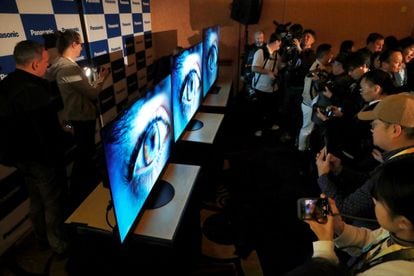CES 2024: Transparent screens on which you can make purchases? This will be the television of the future | Technologies
/cloudfront-eu-central-1.images.arcpublishing.com/prisa/QMMWV5EYUWIUEANZIK7Q4GAN34.jpg)
Wireless TVs that mount to the wall roll up for storage and remain out of sight or rotate to stand upright. These are some of the devices that have been showcased at CES, the world’s largest consumer electronics show, in recent years. At the event, which is taking place this week in Las Vegas, USA, tech giants such as Panasonic, Samsung and LG showcased their most powerful and innovative TVs with which they aim to revolutionize the smart home.
These devices increasingly have larger screens with better picture quality, as Jessica Booth, director of market research at CTA, the US technology industry association that organizes CES, points out. Despite this, the expert insists that television “is much more than a simple screen.” It has begun to take the first steps to become “a smart home hub that goes beyond entertainment into streaming“
“It becomes an intelligent command center that will connect devices like the kitchen and laundry room, or access your security cameras to show you what they’re recording,” he says. And it goes further. TVs are predicted to become an e-commerce platform that will allow consumers to purchase goods and services while watching programs.
Jakub Pesl, an employee at Panasonic, also believes that television will primarily be the center of the home: “People will still sit back and enjoy quality entertainment, but they will also be able to control any device in the home.” “It’s hard to predict what the future of television will be like because everything is moving so quickly. I’m envisioning a screen where you can video chat with friends or see who’s ringing the doorbell, and a remote control with a button that lets you tell your autonomous car to come to the door.”

We’ll still have to wait to see if these predictions come true. At CES, manufacturers are showing off what their devices are currently capable of. Panasonic, which invited EL PAÍS to the exhibition, announced that starting in 2024, Amazon Fire TV will be integrated into its TVs. In a demo provided to this newspaper, a Panasonic employee gave Alexa several commands, from playing a TV series to turning on the lights or closing the curtains.
While many companies are looking to turn TVs into the brains of the smart home, there are those who are highlighting the potential of these devices elsewhere. Such is the case with David Gold, president of Hisense Americas, who believes the capabilities of its screens “extend beyond home entertainment and into many aspects of everyday life, such as hospitals, classrooms, stadiums, offices and museums.”
Wireless and transparent TVs
If there’s one thing that’s clear after visiting the fair, it’s that manufacturers are looking for ways to surprise users. A man walks around a fair with a TV on in his hands to demonstrate that it is completely wireless. This is Balaji Krishnan, founder and CEO of Displace, a company that made headlines in 2023 by releasing the first wireless TV that attaches to the wall “like magic.”
“We experimented with a lot of different technologies. For example, with rollable TVs, wireless TVs and see-through TVs,” boasts Jennifer Solovey, an LG employee who believes that over time, “there will be markets for all these devices.” Transparent screens aren’t really new. Some manufacturers have been showing prototypes for many years.
But now LG has launched the LG Signature OLED T, the first wireless TV with a transparent panel, which will theoretically go on sale this year. Hundreds of people came to CES to record this 77-inch panel on their mobile phones. It plays a movie and looks like a regular TV. Suddenly, what appears to be a black curtain slowly closes and the screen becomes transparent. The goal is that the device can be placed in the middle of a room and go unnoticed, although it can also show fish or other animations. Samsung doesn’t want to be left behind and took the opportunity to announce a fully transparent micro-LED TV.
Artificial intelligence
Artificial intelligence is the main character at CES. Chung-Hee Han, vice president and general manager of Samsung, believes that this technology will allow connected devices to improve people’s daily lives without being intrusive and always remaining “in the background.” Thanks to this, TVs can make personalized recommendations and interact with other devices.
This technology also serves to optimize picture and sound. The TVs Panasonic unveiled at CES (the Z95 and Z93 models) feature a processor that uses artificial intelligence to produce a brighter panel with a higher level of detail. Apart from images, sound is also especially important for identifying places or characters in films, enhancing atmosphere and evoking the senses. Samsung is working on Active Voice Amplifier Pro technology, a system that analyzes voice and background noise using artificial intelligence to optimize the listening experience and “the ability to enjoy a variety of content as if you were in the front row at a stadium or movie theater.” .
Achieving maximum immersion is also a priority for companies like Panasonic. To achieve this, their TVs are equipped with multiple speakers at the back. Additionally, they have a mode called sound focus which allows you to direct sound to a specific location in the room. “Perhaps one person listens to TV while another prefers to remain silent or sleep in the same room,” explains Gabor Zegner, marketing and communications manager for home entertainment in Europe at Panasonic.
You can follow El Pais Technology V Facebook And X or register here to receive our weekly newsletter.
